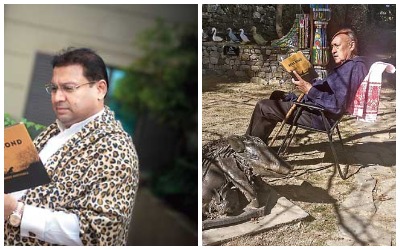Perhaps one of India’s best kept secrets, Bera is a small village in Pali district of Rajasthan, about 140km from Udaipur. What put the village on the map is the peaceful co-existence of around 55 leopards with the villagers, intriguing wildlife enthusiasts worldwide. It was on a chance visit to the area with his dear friend and environmentalist Shatrunjay Pratap Singh that author and philanthropist Sundeep Bhutoria discovered this land. Singh, who has chosen to return to India and settle in Bera, actively works towards its conservation. What Bhutoria stumbled upon was a marvellous land worthy of the world’s undivided attention. Wildlife experts have debated that the only way to explain this peaceful cohabitation is the behaviour of the humans who never encroach upon the space of the leopards. Using the lockdown to his advantage, he decided to pen down his experience at Bera, and the book The Bera Bond (Pan Macmillan; Rs 750) was born.
At Liloda Hill, 6km from the main village, one can see leopards frolicking around. All one needs is a pair of trained eyes — and a good camera if you are a photography enthusiast. However, the land is not limited to leopards only. One can also expect to see flamingos, saras cranes, bar-headed geese, ruddy shelduck and crocodiles to name a few. “There is no book on this region yet and it has one of the highest density of leopards ensuring 100 per cent sighting chances. I wanted to get people aware, especially to mitigate the human-leopard conflict that has always been in the news. Here is a real example of peaceful coexistence,” said author Sundeep Bhutoria. His knowledge of wildlife is well known and he is often inundated with requests for details of Ranthambore. For Indians, spotting a tiger is what wildlife exploration is about, he tells us and he wants to actively change that perspective. “The silence of the jungles needs a special mention because there is so much more to the exploration of wildlife,” he added.

(L-R) Sundeep Bhutoria, Victor Banerjee Shatrunjay Singh
The introduction of the book is written by actor, philosopher and activist Victor Banerjee, who said, “Sundeep is a Marwari cowboy. He has moved stealthily from tigers to leopards. Someday, between the lines, I hope to discover what drives a strict vegetarian to become such a wild admirer of carnivores. He fascinates me, to say the least.” Juxtaposed with glorious pictures of Zia, Pasha, Heera and more leopards who have been fondly named, discover a glorious side to the Indian wildlife with this coffee table book that would make for a great addition to any bookshelf. The foreword of the book is penned by environmental activist and author Bittu Sahgal, who said, “Our wildlife needs many different people to articulate the case and Sundeep Bhutoria has done so quite beautifully in this book.” Available online and in bookstores, make sure you grab a copy before you begin planning your next wildlife trip.










